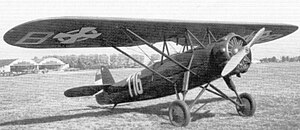Rogožarski SIM-Х
| Rogožarski SIM-X | |
|---|---|
 |
|
| Role | Sports and tourist and basic military trainer |
| National origin | Yugoslavia |
| Manufacturer | Prva Srpska Fabrika Aeroplana Živojin Rogožarski A.D. |
| Designer | Sima Milutinović |
| First flight | 1936 |
| Introduction | 1937 |
| Retired | 1944 |
| Status | inactive |
| Primary user | Yugoslav Royal Air Force and Yugoslav Aeroclub |
| Produced | 1937 to 1941 |
| Number built | 21 |
| Developed from | Rogožarski SIM-II i Rogožarski SIM-VIII |
The Rogožarski SIM-X (Serbian Cyrillic: Рогожарски СИМ-X) was a Yugoslav single-engine sports and tourist plane also used for basic training of military pilots designed in 1936, with two crew members. It was designed and built at the Rogožarski factory in Belgrade.
The SIM-X was designed by Sima Milutinović at the beginning of 1936 drawing on positive experiences of its predecessors SIM-II and SIM-VIII. The prototype was designed in the Rogožarski factory from August to the end of the 1936. The first test flight took place in 1936 when the aircraft was also registered by Rogožarski factory under the code YU-PDY. After detailed test flights had been performed, it was offered to the Yugoslav air force for further tests, which were carried out at the Novi Sad school for pilots. The committee found certain minor flaws but, other than those, it was given an exceptional rating. The SIM-X which was intended for civilian use, sport pilot training, demonstration and tourist flights, was classified by the air force as "a school monoplane, two-seater for the initial training of pilots."
The SIM-X was a single engine, high monoplane parasol wing, with a wooden double-shaft propeller, for two crew members seated in tandem. Although it was envisioned that it would be possible to fit with three different engines: 120 hp Walter NZR, 110 hp Siemens and 120 hp de Havilland Gypsy Major, production aircraft were fitted with the air-cooled radial Walter NZR with a reduction gear. The engines were produced by the S. Vlajković factory Belgrade.
It was mostly of wooden construction, the elliptical cross-section fuselage was entirely made of wood and covered with plywood, and the wings were a wooden structure covered with cloth, with rounded ends. On each side, the wings were supported by a pair of inclined struts which relied on the fuselage. The fuel tank was located in the central part between the wings, that is, at their junction. Landing gear was fixed, no axles, completely made of steel pipe characterized by great strength which enabled the aircraft to land on very rugged terrain.
With the introduction of instrument flight training for military pilots in 1939, all Yugoslavian aircraft manufacturers tried to make a school plane for this purpose. Rogozarski thought that it would be best to adapt SIM-X for that purpose. At the same time they wanted to replace the radial Walter engine with the 6 cylinder, in-line, air-cooled 132 hp Gypsy Major which was at the time a very popular engine used in trainers and holiday sports aircraft while the Yugoslav Royal Air Force intended to use it as the basic aircraft engine for their school aircraft. Since Rogožarski was not able to acquire an engine, the factory borrowed it from “Aeroput” company. The prototype complete with all adequate instrumentation was submitted to the army for further testing in 1940, with the aircraft designated SI-GIP Since the aircraft did not meet all the requirements and expectations of the YRAF command, they did not buy the SI-GIP aircraft prototype.
...
Wikipedia
